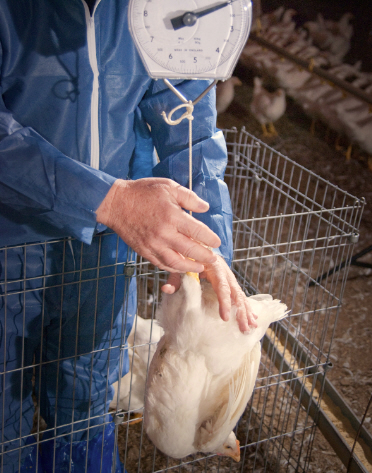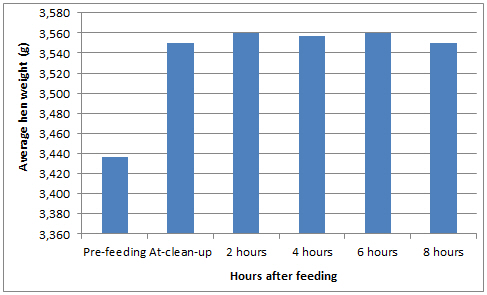



Accurate Weighing of Parent Stock is Vital to Monitor Flock Progress
The proper sampling and accurate weighing of breeder pullets and hens during their life is both important and necessary, according to Pete Sbanotto, product manager for Cobb-Vantress, Inc.
Knowing the flock's status on weight and body composition gives the producer and technical service personnel the information necessary to make the best decisions for long-term performance.
This information is vital at any stage during rearing and production, as feed management decisions based on incomplete or inaccurate weights could easily cause the flock to become underweight or overweight. Weights above or below the recommended standards could compromise the ideal body composition, and in either case could result in a 10- to 15-egg per hen decrease in life-of-flock hatching egg production.
Rearing Period
There are techniques for the correct rearing of pullets that should be observed at all times. Although some locations are using the electronic platform scales to collect many weights during the course of every day, there are a few challenges with this method.
Firstly, if the pullets and cockerels are raised together, setting the scale weight limits to exclude the male weights from the female weights becomes at best an art of estimating the break-over point. Platform scales will give a more accurate result if used where the sexes are raised separately.
Also, the total number of weight recordings in a day does not necessarily reflect many different chickens, as some birds will stand on the scale multiple times during the day. Move the scale location within the house several times during the life of the flock to get a better sampling of weights.
While the actual bodyweight of the pullet is an easily documented measurement of the flock's progress, primary breeder companies are concentrating on attaining the proper body composition during the time prior to light stimulation of the flock. To know the body composition of birds in the flock, it is necessary for the technician to handle birds often.
Birds should be weighed every week from seven days of age through peak production and the weights recorded, and should always be weighed individually on an off-feed day, or before feeding if the flock is fed daily. Recording individual weights allows the calculation of flock uniformity. Handling of the birds during the weighing process gives the technician an opportunity to make any needed adjustments in a timely manner.
The number of birds to be weighed varies. Basically, weighing pullets in two or three locations in each house or pen is best. It is important that after birds are penned for weighing, weigh every bird in the pen. Do not reject any weights. A more accurate sampling may be attained by opening up the catch pen and moving away, allowing time for the birds to walk into the pen without driving them.
If the weights of the flock are not following the recommended guideline, an investigation must be made quickly to determine the cause. Possibilities include disease challenges, temperature or air quality issues, inadequate feed space for all birds to eat, slow feed delivery times, feed formulation or quality problems, or even inaccuracy of the feed weigh scales.

There are certain times during rearing when weights are critical. The first would be at seven days of age, when the technician can decide if the flock has been started properly as well as make any adjustments to improve uniformity by beginning the grading process. The next important weight is at around four weeks of age. The proper weight and protein consumption (grams of crude protein consumed by each bird) should be calculated at this time, and compared to the recommendations from the primary breeder.
The next critical time is at 15 to 16 weeks. From this time until light stimulation, consistent and proper weight gains are important. A weight gain of 33 to 35 per cent in the period between 16 and 20 weeks is needed to flesh the pullets properly and add some fat reserves to prepare the birds properly for daylength increases. If the weights are above standard at 16 weeks, it is difficult to accomplish the proper fat deposition without the flock becoming overweight.
The tendency is to try to bring the overweight flock back to the recommended standard, and doing this retards the development of the body composition. A female put into light stimulation before her body composition tells her that she is prepared for reproduction will not respond to the daylength increase by maturing her reproductive tract and developing egg follicles. Instead, she will gain weight and put on fat until she is ready for production but the stimulation of the first and largest daylength increase is already lost.
* "Hens can be weighed at any time after two hours post feed clean-up with no change in the accuracy of the hen weights" |
Production Period
Research at the University of Georgia in the US has shown that when the pullets are moved to the production house, feeding should be done daily, as the maturing pullet needs consistent nutrient inputs to mature properly. Again, the flock needs to be weighed at least weekly from housing through peak production.
The weighing of hens is sometimes compromised by the hen having a certain amount of feed in her system after consuming her daily ration. Accurate weights have been generally considered to be 'empty' weights in order to get the true weight of the hen without the added complication of guessing how much to adjust the weight because of feed in her system.
Contrary to this belief, research at the University of Arkansas shows that hen weights tend to remain constant all through the day at any time beginning at two hours after feed cleanup. This would indicate that the technician gathering the flock data does not really need to wait until after midday to do the weighing, and the results would still be just as accurate.

The weights in Figure 1 were taken by including all birds of the same pen during each weighing so no sample error would enter into the data. These hens were being fed 139 grams per bird (30.55lb/100) on an every-day basis. The weight patterns are typical of any age for hens in production, and are consistent and repeatable over a wide range of hen ages and weights, even including onset of lay.
This research concludes that hens can be weighed at any time after two hours post clean-up with no change in the accuracy of the hen weights. This could help the technician make more productive use of the complete workday if there are several flocks to be weighed in a day's time.
Hen weights need to be monitored throughout the life of the flock to know if it is progressing properly. In the period from onset of lay (normally defined as the week of three per cent production) to peak, the flock needs to gain from 18 to 20 per cent in weight. Less than 18 per cent indicates that the hen may not be receiving enough nutrients for production and weight gain, which could affect persistency of lay. Conversely, too much gain - over 20 per cent - indicates that the hen is receiving more nutrients than she needs and could easily become overweight, which also affects persistency.
Hen weight is a good tool to monitor the flock status but other factors are also important in determining the feeding protocol. For example, if the flock is gaining properly but feed consumption time is excessively short or long, it indicates the direction that the flock weight could take in the following couple of weeks.
Feed consumption times greater than three-and-a-half to four hours would indicate that the flock could be receiving too much feed, and that the weights would be expected to go up. Conversely, if the feed is cleaned up in less than one to one-and-a-half hours, we would expect the following week's weight gains to be less than expected.
Hens should be weighed at least every two weeks after peak to ensure that the feed allowance is being reduced properly. Weighing may need to be done more often in instances when weight gains are not meeting expected standards. Although every flock is a bit different, a common goal is to reduce the peak feed amount by 12 to 14 per cent over a period of several weeks. This percentage would need to be modified according to the weight of the flock as it ages. The hens need to be gaining slowly after peak for the best persistency. Constant weight monitoring will allow accurate feed withdrawal.
Summary
Individual bird weights are important to monitor the progress of the flock. The weight progress and uniformity of the flock can be monitored, and the egg performance can be compared to the actual weight history to fine-tune a flock programme. But this must be augmented with the regular handling of the flock, including recording the body composition and fat reserves before light stimulation. Attention to these details most often results in more consistent production, higher peaks and better persistency.
February 2013








